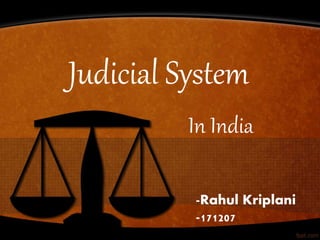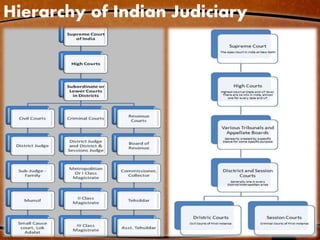The document provides an overview of the Indian judicial system, including its hierarchy and major components. It begins with the Supreme Court, then discusses high courts, civil courts, criminal courts, revenue courts, and Lok Adalats. It notes major issues facing the system like high pendency, corruption, lack of transparency, and under trials. It concludes by outlining steps that could help speed up the judicial process, such as increasing judges, modernizing courts, and removing outdated laws.



























![them had the case been settled on a period and,
expecting it was ruled against them. Additionally,
every one of the costs, torment and desolation that are
utilized by them to protect themselves in courts are
more awful than serving the genuine sentence. Under
preliminaries are not blameworthy till sentenced. Then
again, the rich and great individuals can convey the
police to their sides, and the police can pester or quiet
hindered and poor people, amid the long trials in the
courts.[11]](https://image.slidesharecdn.com/indianjudiciary-191008103618/85/Indian-judiciary-Introduction-Problems-and-Solution-28-320.jpg)

















